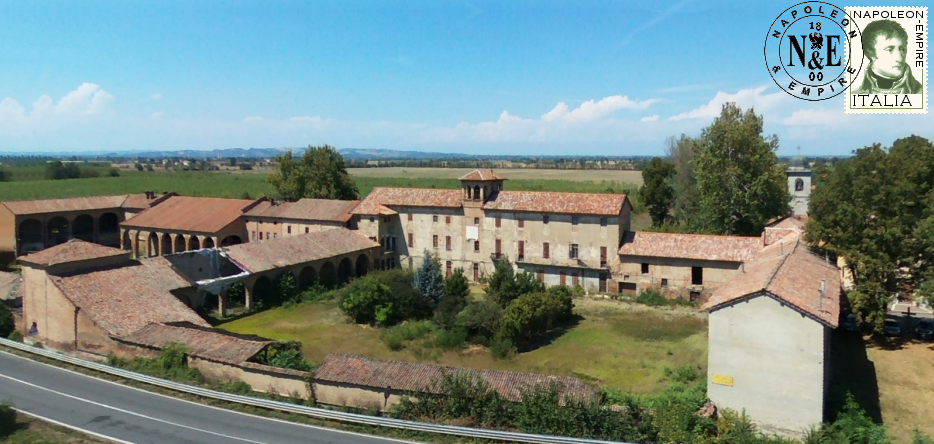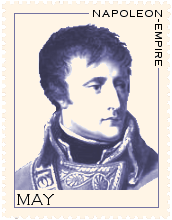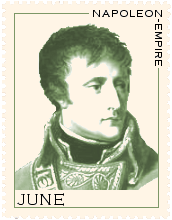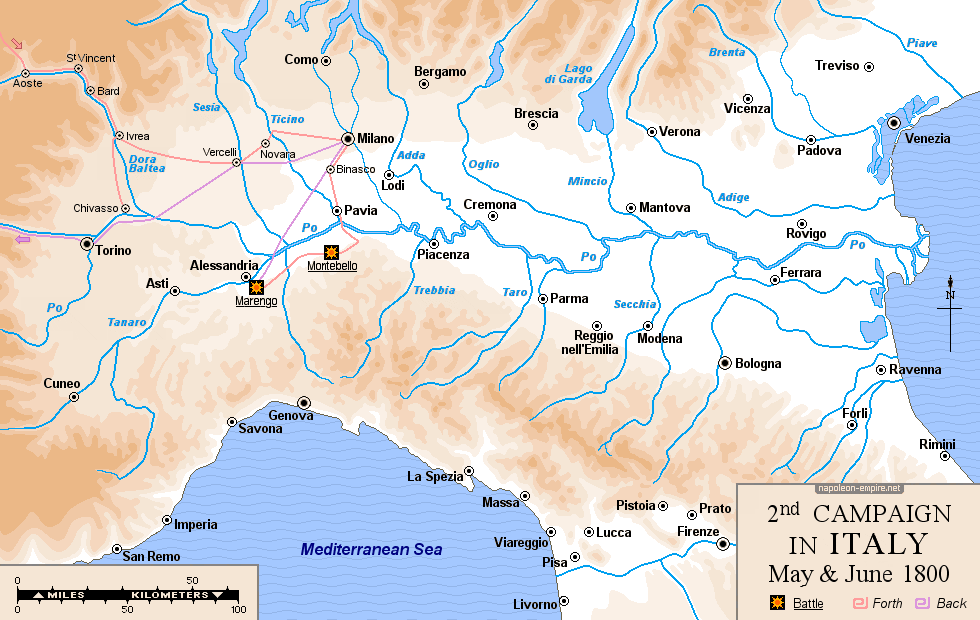The Italian Campaign of 1800 day by day
In May and June 1800, First Consul Napoleon Bonaparte faced again, on the same terrain, his enemy from the Italian campaign of 1796-1797: Austria, allied within the framework of the second coalition with another continental empire: Russia. With the key, once again, a military success - but the fate of arms was narrowly unfavorable to him.
However, it would be a new victory, that of General Jean Victor Marie Moreau at Hohenlinden on December 3, which would led Austria to negotiate (Peace of Lunéville on February 9, 1801), then its allies (Treaty of Florence on March 18, 1801 with the Kingdom of Naples, Treaty of Paris on October 8, 1801 with Russia, then Treaty of Amiens on March 25, 1802 with England).

We followed in the footsteps of the First Consul (perfectly defined for more than two centuries, and without major disagreement between the different authors, unlike the campaign of 1796-1797), and illustrated this journey by capturing in images the aspect that these places, packed with history, currently offer. This iconography will not fail to be enriched with each of our future stays there, as it should be.
May 1800

- May 6 - First Consul Napoleon Bonaparte left Paris at night in the company of Louis Antoine Fauvelet de Bourrienne . After having lunch in Sens , at the latter's house, he reached Avallon in the early evening, and slept there.
- May 7 - Having left at dawn, he was in Dijon at noon, where Géraud Christophe Michel Duroc was waiting for him; he reviewed the troops near the Burgundian capital.
- May 8 - Napoleon Bonaparte left for Auxonne , Dole, Champagnole, Morbier, Morez, Les Rousses where he dined, Saint-Cergue and finally Nyon , where he slept at the post house.
- May 9 to 11 - Early in the morning, he went down to Geneva, where he stayed until the 12th of the month at Nicolas Théodore de Saussure's [now No. 2 Rue de la Tertasse]. The strategy of the campaign was refined in a council of war, and the route to take was chosen with precision. On May 10, he received Jacques Necker, former Minister of Finance and Minister of State of King Louis XVI. On the 11th, he dined at General Berthier's in the Picot house [now No. 12 Place de la Fusterie], then went to Beaulieu, to the De Sellons, whose mansion he planned to rent .
- May 12 to 16 - Napoleon was in Lausanne, where he stayed in the Villamont district on the heights, guest of the banker Rodolphe Emmanuel de Haller. On the 12th, he reviewed the Chambarlhac and Loison divisions on the plain of Saint-Sulpice , seven kilometers west of the city. He then carried out a few inspections, notably on the 13th in Vevey where he reviewed 6,000 soldiers from the Boudet division on the Place du Marché, in Villeneuve with inspection of the warehouses and in Saint-Maurice-du-Valais, on the road to Martigny.
- May 16 - Napoleon left Lausanne in the middle of the afternoon, followed the northern shore of Lake Geneva , passed Vevey and Montreux in the evening, then headed south-southeast to Aigle and then Saint-Maurice-du-Valais where he slept at the abbey .
- May 17 - He continued in the same direction to Martigny , where he stayed at the Bernardins convent (provostship of the Great Saint Bernard) [46.10028, 7.07356]. Guest of the provost Louis-Antoine Luder , Napoleon stayed on the first floor.
- May 18 to 20 - He waited in Martigny for the news to reach him of the capture by the vanguard of the fort of Bard, which closed the valley of the Dora Baltea by covering the road to Ivrea.
- May 20 - He left Martigny on horseback around 8 o'clock (or much earlier, at night, according to other sources). He went to Liddes where he had lunch with the priest Pierre-Joseph Rausis then to Bourg Saint-Pierre where the road ended and where he had a snack at the inn of the Colonne miliaire . There, he hired a guide, Pierre Nicolas Dorsaz. The weather was terrible. Shortly before the village of Proz [nowadays submerged by the Toules dam ] the mule ridden by the First Consul stumbled and narrowly missed falling into the ravine on his right but Dorsaz intervened promptly and saved his client's life. Then they climbed the slopes of the Grand Saint-Bernard Pass , along the torrents Tronchets [Trontsë] and Barasson , and arrived at the hospice , located at the top of the pass at an altitude of 2,469 meters, around 5 p.m. (or even late morning according to other sources). Two hours later, after a meal offered by Father Berenfaller (or Baerenfaller), prior of the convent, Napoleon set off again. He passed through Saint-Rhémy-en-Bosses and reached Etroubles around 9 p.m.; he slept there at the rectory .
- May 21 - He arrived in Aosta and went down to the episcopal palace . He stayed there until the 25th. On the 22nd, he visited the Roman fortifications of the city and watched the Italian legion parade from the top of the triumphal arch of Augustus .
- May 25 - Napoleon left Aosta and followed the Dora Baltea eastward to Saint-Vincent , then probably via the Joux pass (1640 meters above sea level) and Brusson , veering southward to Verrès . But, further downstream, if the village of Bard had been indeed taken during the night of May 21-22 by the Loison division, the fort overlooking it , held by 500 to 600 men commanded by Captain Josef Stockard von Bernkopf and heavily armed (20 artillery pieces), was still resisting the assaults of the French. Napoleon went to the heights of Albaredo [Albard de Bard] [45.61238, 7.75951] to study the terrain , then returned to spend the night with the Augustinians of the collegiate church of Saint-Gilles in Verrès, guest of the provost Jean-François Chentre.
- May 26 - Napoleon bypassed the fort of Bard on foot by paths passing through Albard and the hamlet of Rovarey, then found a horse to reach Ivrea to the south-southeast, where he settled in the Palazzo Perrone . A few kilometers south of the city, the battle of the Chiusella bridge took place , in which the 6th Light Division, together with the 22nd and 40th Divisions, engaged the cavalry of General Károly József Hadik von Futak with bayonets and routed it.
- May 28 - The First Consul left Ivrea in a southerly direction, and slept at the presbytery of Chivasso , to the northeast of Turin [Torino], on the banks of the Po River.
- May 29 - He returned to Ivrea.
- May 30 - He left Ivrea around midnight, for Santhià then Vercelli , to the east-southeast, where he spent the following day at the Palazzo Avogadro della Motta [nowadays located at Via Duomo, n° 20].
June 1800

- June 1st - Napoleon continued towards Novara , on the road to Milan [Milano].
- June 2nd - He crossed the Ticino River and had lunch at Turbigo, at the Hotel de la Couronne de France. He left by carriage, passed through San-Pietro-in-Sala and entered Milan through the Vercelli Gate. In the Lombard capital, he settled in the Archducal Palace.
- June 3 to 8 - He remained in Milan.
- June 9 - He left towards the south: Binasco , then Pavia, Stradella and Casteggio where Jean Lannes reported to him on the Battle of Montebello which had just ended. Napoleon returned to sleep in Stradella.
- June 10 and 11 - He was at Stradella.
- June 12 - Heading west-southwest, for Voghera, where he settled in the town hall.
- June 13 - Under a rain that hardly stopped all day, Napoleon went to San Giuliano-Nuovo, in the Bormida plain, then to the tower of Marengo , then to the springs of Fontanone. He then went to the banks of the river Scrivia , had lunch at Sale [44.98386, 8.80879], before returning to S. Giuliano-Vecchio . He went to have dinner and sleep at Torre di Garofoli , guest of the local baron.
- June 14 - It was the day of the Battle of Marengo, one of the finest military pages of the Napoleonic epic. The Austrians, who were in Alessandria and in front of it, crossed the bridgehead they had set up on the Bormida River and came to confront the French. On the evening of the battle, once the victory had been won with difficulty, Napoleon returned to Torre Garofoli , where his cook Dunand (or Dunan, or Dunant, François Claude Guignet, known as -) served him, according to legend, a dish made "by chance" but which would become very famous: the Chicken Marengo .
- June 15 and 16 - Still at Torre Garofoli, on the 15th he received Generalmajor Johann Ferdinand von Skal und Großellgut, who came to negotiate a suspension of arms, and on the 16th reviewed the troops at S. Giuliano Vecchio .
- June 16 and 17 - He left for Milan, where he entered through the medieval Ticinese Gate [not to be confused with the one of the same name that would be built from 1802 to 1814, at his initiative].
- June 18 to 24 - Stay in Milan for the First Consul, who attended a Te Deum at the cathedral on the 18th, and received André Masséna on the 22nd, whom he appointed commander-in-chief of the new Army of Italy.
- June 25 - He left Milan for Vercelli, where he met at the Palazzo Avogadro della Motta with Cardinal Carlo Giuseppe Filippa della Martiniana . This meeting would participate in the change of policy towards the Holy See, which would lead to the Concordat of 1801.
- June 26 - Napoleon arrived in Turin .
- June 27 - He returned to France via the Mont-Cenis pass, and slept in Saint-Jean de Maurienne. The second Italian campaign was over for him. The next day he would be in Lyon, five days later at the Tuileries Palace.
Map of the Italian campaign of 1800

 All of Napoleon's movements from 1769 to 1821
All of Napoleon's movements from 1769 to 1821
Photos credits
Photos by Lionel A. Bouchon.Photos by Didier Grau.
Photos by Michèle Grau-Ghelardi.
Photos by Marie-Albe Grau.
Photos by Floriane Grau.
Photos by various authors. Our warmest thanks to Mr Ugo Valfer.